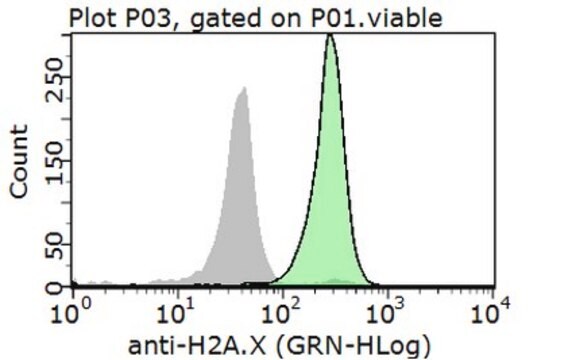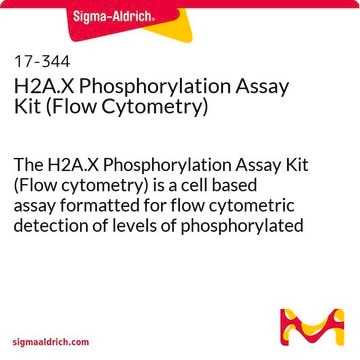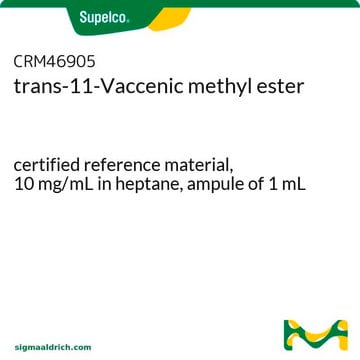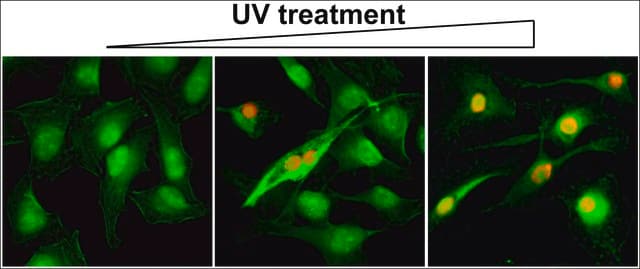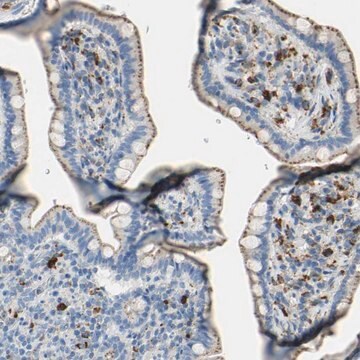Wichtige Dokumente
CWA-1130
Anti-Human Histone H2A.X (1C22) ColorWheel® Dye-Ready mAb
Synonym(e):
H2a/x;Histone H2AX
About This Item
Empfohlene Produkte
Biologische Quelle
rabbit
Qualitätsniveau
Antikörperform
purified antibody
Antikörper-Produkttyp
primary antibodies
Klon
1C22, monoclonal
Produktlinie
ColorWheel®
ZooMAb® learn more
Form
lyophilized
Mol-Gew.
calculated mol wt 15.15 kDa
Aufgereinigt durch
using Protein A
Speziesreaktivität
human
Speziesreaktivität (Voraussage durch Homologie)
mouse, rat
Verpackung
antibody small pack of 25 μL
Grünere Alternativprodukt-Eigenschaften
Waste Prevention
Designing Safer Chemicals
Design for Energy Efficiency
Learn more about the Principles of Green Chemistry.
Methode(n)
flow cytometry: suitable
Isotyp
IgG
Epitopsequenz
C-terminal
Protein-ID-Hinterlegungsnummer
UniProt-Hinterlegungsnummer
Kompatibilität
for use with ColorWheel® Dyes (Required, (Sold Separately))
Grünere Alternativprodukt-Kategorie
Lagertemp.
2-8°C
Posttranslationale Modifikation Target
unmodified
Angaben zum Gen
human ... H2AX(3014)
Allgemeine Beschreibung
Spezifität
Immunogen
Anwendung
Evaluated by Flow Cytometry in Fixed and permeabilized HepG2 cells.
Flow Cytometry Analysis: Intracellular staining of one million fixed and permeabilized HepG2 cells was performed using 5 μL of a 1:1 mixture of Cat. No. CWA-1130, Anti-Human Histone H2A.X (1C22) ColorWheelColorWheel® Dye-Ready mAb and Cat. No. CWDS-PE ColorWheelColorWheel® Antibody-Ready Phycoerythrin (PE) Dye or the equivalent amount of Cat. No. CWA-1053 Rabbit IgG isotype control and Cat. No. CWDS-PE ColorWheelColorWheel® Antibody-Ready Phycoerythrin (PE) Dye.
Tested Applications
Flow Cytometry Analysis: Intracellular staining of one million fixed and permeabilized Hep G2 cells was performed using 5 μL of a 1:1 mixture of Cat. No. CWA-1130, Anti-Human Histone H2A.X (1C22) ColorWheelColorWheel® Dye-Ready mAb and Cat. No. CWDS-APC ColorWheelColorWheel® Antibody-Ready Allophycocyanin (APC) Dye or the equivalent amount of Cat. No. CWA-1053 Rabbit IgG isotype control and Cat. No. CWDS-APC ColorWheelColorWheel® Antibody-Ready Allophycocyanin (APC) Dye.
Note: Actual optimal working dilutions must be determined by end user as specimens, and experimental conditions may vary with the end user
Evaluated by Flow Cytometry in Fixed and permeabilized HepG2 cells.
Flow Cytometry Analysis: Intracellular staining of one million fixed and permeabilized HepG2 cells was performed using 5 μL of a 1:1 mixture of Cat. No. CWA-1130, Anti-Human Histone H2A.X (1C22) ColorWheelColorWheel® Dye-Ready mAb and Cat. No. CWDS-PE ColorWheelColorWheel® Antibody-Ready Phycoerythrin (PE) Dye or the equivalent amount of Cat. No. CWA-1053 Rabbit IgG isotype control and Cat. No. CWDS-PE ColorWheelColorWheel® Antibody-Ready Phycoerythrin (PE) Dye.
Kompatibilität
Zielbeschreibung
This ColorWheel® Dye-Ready monoclonal antibody was developed using our ZooMAb® recombinant monoclonal antibody (Cat. No. ZRB1663). It offers significantly enhanced specificity, affinity, reproducibility, and stability over conventional monoclonals.
Physikalische Form
Rekonstituierung
Lagerung und Haltbarkeit
Rechtliche Hinweise
Haftungsausschluss
Sie haben nicht das passende Produkt gefunden?
Probieren Sie unser Produkt-Auswahlhilfe. aus.
Erforderlich, aber nicht bereitgestellt
Lagerklassenschlüssel
11 - Combustible Solids
WGK
WGK 2
Flammpunkt (°F)
Not applicable
Flammpunkt (°C)
Not applicable
Hier finden Sie alle aktuellen Versionen:
Analysenzertifikate (COA)
Die passende Version wird nicht angezeigt?
Wenn Sie eine bestimmte Version benötigen, können Sie anhand der Lot- oder Chargennummer nach einem spezifischen Zertifikat suchen.
Besitzen Sie dieses Produkt bereits?
In der Dokumentenbibliothek finden Sie die Dokumentation zu den Produkten, die Sie kürzlich erworben haben.
Active Filters
Unser Team von Wissenschaftlern verfügt über Erfahrung in allen Forschungsbereichen einschließlich Life Science, Materialwissenschaften, chemischer Synthese, Chromatographie, Analytik und vielen mehr..
Setzen Sie sich mit dem technischen Dienst in Verbindung.
